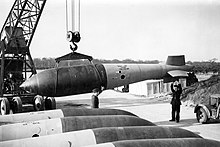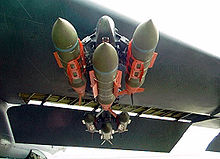Aerial bomb





An aerial bomb is a kind of bomb designed to travel through the air with predictable trajectories, usually designed to be dropped from an aircraft. This includes a vast variety and complexity in designs, from "dumb" (simply dropped) to "smart" (remote or self guided), hand tossed from a vehicle, to needing a large special built vehicle, or maybe be the vehicle itself such as a Glide bomb, instant detonation or Delay-action bomb. The act is termed Aerial bombing.
Early history
The first bombs delivered to their targets by air were launched on unmanned balloons, carrying a single bomb, by the Austrians against Venice in 1849. Before this the Napoleonic armies used balloons for reconnaissance.[1] The first air-dropped bomb from a powered aircraft was dropped when Lieutenant Giulio Gavotti of the Italian Army dropped four grenades from his Blériot aircraft onto an Ottoman military encampment at the Taguira oasis in Libya on 1 November 1911.[2]
Following Italy's bombing, a second bombing occurred in Mazatlan, Mexico during the Mexican Revolution.[citation needed] General Venustiano Carranza (later president of Mexico) intent on taking the city of Mazatlan, ordered a biplane to drop a crude bomb of nails and dynamite wrapped in leather on Neveria Hill adjacent to the city's downtown area.[citation needed] The bomb was crude, and the art of bombing was even cruder. The bomb did not land on the target but on the city streets. The bomb killed two citizens and wounded several others.
The dropping of bombs from balloons had been outlawed by the Hague Convention of 1899, but Italy argued that this ban did not extend to aircraft.[2] (See Aerial bombardment and international law).
Later bombings
In 1912, during the Balkan War, Bulgarian Air Force pilot Christo Toprakchiev suggested the use of aircraft to drop "bombs" (called grenades in the Bulgarian army at this time) on Turkish positions.[citation needed]
Captain Simeon Petrov developed the idea and created several prototypes by adapting different types of grenades and increasing their payload.[3]
On 16 October 1912, observer Prodan Tarakchiev dropped two of those bombs on the Turkish railway station of Karaagac (near the besieged Edirne) from an Albatros F.II aircraft piloted by Radul Milkov. This was the first use of an aircraft as a bomber.[3][4]
After a number of tests, Petrov created the final design, with improved aerodynamics, an X-shaped tail, and an impact detonator. This version was widely used by the Bulgarian Air Force during the siege of Edirne. Later a copy of the plans was sold to Germany, and the bomb, codenamed "Chataldzha" ("Чаталджа"), remained in mass production until the end of World War I. The weight of one of these bombs was 6 kilograms. On impact it created a crater 4-5 meters wide and about 1 meter deep.[citation needed]
In 1913, Greek naval aviation forces dropped four bombs on the Ottoman fleet in the Naval Battle of Lemnos.
The first bomb to be dropped by a German aircraft on the United Kingdom landed near Dover Castle on December 24, 1914.[5]
See also
- Unguided bomb
- Precision-guided munition
- Strategic bombing
- Bomber
- Concrete bomb
- List of Japanese World War II navy bombs
- List of Japanese World War II army bombs
References
- ^ Millbrooke, Anne (2006). Aviation History. Jeppesen. pp. 1–20. ISBN 0884872351.
- ^ a b Grant, R.G. (2004). Flight - 100 Years of Aviation. Dorling-Kindersley Limited. p. 59. ISBN 1-4503-0575-4.
{{cite book}}: Check|isbn=value: checksum (help) - ^ a b Who was the first to use an aircraft as a bomber? (in Bulgarian; photographs of 1912 Bulgarian air-dropped bombs)
- ^ A Brief History of Air Force Scientific and Technical Intelligence
- ^ Hardy, R.E. "Military History Journal - Vol 4 No 6 : Some Aspects of Night Bombing over Europe". The South African Military History Society. Retrieved 2008-03-14.
